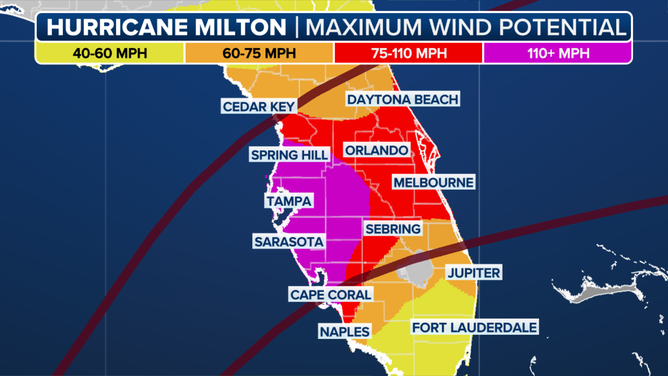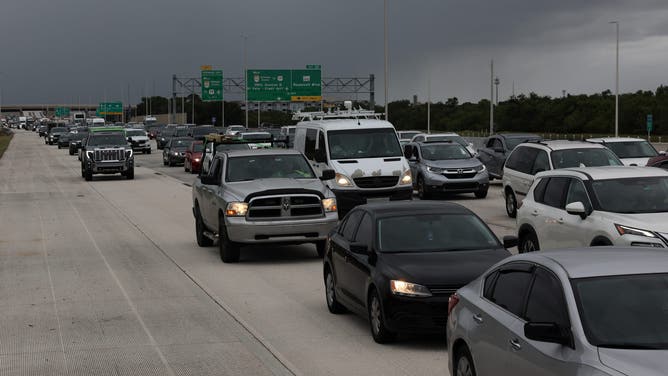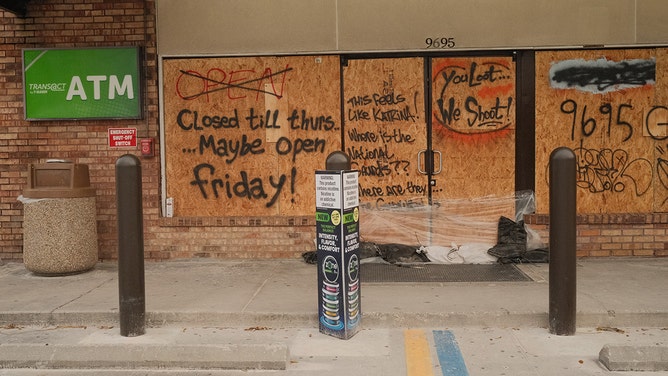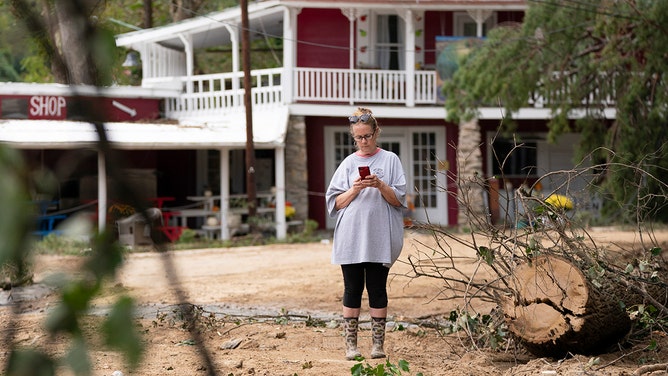Florida
Millions brace for Milton's wrath as Category 5 hurricane barrels toward Florida as time runs out to evacuate

Hurricane Milton is once again a Category 5 cyclone and is expected to remain a powerful hurricane through landfall on Thursday.
TAMPA, Fla. — Millions in Florida are bracing for a potentially catastrophic punch from major Hurricane Milton, which threatens a historically deep and dangerous storm surge to a large swath of Florida’s west coast along with wind gusts well over 100 mph when the storm strikes Wednesday night or Thursday morning.
Milton regained Category 5 strength Tuesday evening, a day after becoming among the strongest hurricanes on record in the Atlantic basin. When it reaches the Florida coast, it is still forecast to be a major hurricane.
TRACKING HURRICANE MILTON: FORECAST CONE, SPAGHETTI MODELS, LIVE RADAR AND MORE
“It’s worth emphasizing that this is a very serious situation,” the National Hurricane Center warned on Tuesday. “Milton has the potential to be one of the most destructive hurricanes on record for west-central Florida.”
Hurricane Hunters investigate Milton while it was strengthening over the Gulf of Mexico.
State officials have been scrambling since Monday to get millions off vulnerable coastlines in what is described as the largest mass evacuation in Florida since Hurricane Irma in 2017. Storm surge forecasts along the central western coast are predicting 10–15 feet of water topped with devastating waves driven by hurricane-force winds. Those levels — significantly higher than the damage wrought just last month by Hurricane Helene — would surpass anything seen in over a century in the Tampa Bay area.
“Yes, you might have ‘been through hurricanes before,’” FOX Weather Hurricane Specialist Bryan Norcross said. “But you weren’t through the 1921 storm that put water over much of Pinellas County, or the 1848 hurricane that put 15 feet of Gulf water where downtown Tampa is today.”
(FOX Weather)
The Florida National Guard has mobilized 5,000 troops to assist with the response, with an additional 3,000 expected to be deployed before the storm makes landfall. The Florida Department of Transportation opened the shoulders on Interstate 4 and Interstate 75 going north to help speed up evacuations, and tolls have been suspended.
“Before Hurricane Ian hit Southwest Florida, some people got confused, ended up making terrible decisions, and died, Norcross said. “Don’t let that happen to you.”
FOX Weather Correspondent Robert Ray shows the lingering destruction along Bradenton Beach from Hurricane Helene’s storm surge amid forecasts of storm surge reaching several feet higher with Hurricane Milton.
Florida Gov. Ron DeSantis declared a State of Emergency over the weekend for 51 of the state’s 67 counties, and on Monday, President Joe Biden approved the state’s pre-landfall emergency declaration request.
HURRICANE MILTON’S WINDS COULD RAM CONSTRUCTION CRANES INTO DOWNTOWN ST. PETE BUILDINGS
Shelters have started opening and the state has partnered with Uber to provide residents with free rides to and from shelters for those trying to escape Milton’s eventual wrath. To the north, Atlanta Motor Speedway said it was opening its campgrounds free of charge to evacuated Florida residents.

(FOX Weather)
On Tuesday, the first evacuations were ordered on Florida’s east coast in St. John’s County, including St. Augustine Beach. The county will experience a storm surge from the backside of Milton as it barrels across the state.
Devastating winds to tear across the heart of the state
Aside from the life-threatening storm surge, Milton is forecast to bring wind speeds well over 100 mph around the eyewall where the hurricane makes landfall. That includes the Tampa area, which has potential wind gusts over 95 mph or more at landfall.

Milton Wind Threat
(FOX Weather)
But even after landfall, damaging winds are expected to track across the central Florida Peninsula. Milton is forecast to maintain hurricane strength even through its trek along the Atlantic coast, with Hurricane Warnings covering 11 million including the Orlando area and along the east coast from the St. Lucie/Martin County Line northward to Ponte Vedra Beach.
‘MAJOR GLOBAL EVENT’: MILTON COULD BE WESTERN FLORIDA’S HURRICANE KATRINA, SUPPLY CHAIN EXPERT WARNS
Storm surge will also be felt along the Atlantic coast of Florida from the Space Coast to the First Coast. This includes cities such as Daytona Beach, St. Augustine and Jacksonville Beach.
Rainfall totals will reach 8-12 inches along Milton’s path with isolated totals reaching 18 inches. And Milton will present a threat of scattered tornadoes even ahead of landfall.
There is an increased risk of tornadoes ahead of Milton’s landfall on Wednesday. FOX Weather Meteorologist Ian Oliver has the forecast.
Schools, airports, theme parks close
As Floridians hunker down to ride out the storm, widespread closures of businesses, schools and travel hubs are common.
Tampa International Airport (TPA) suspended operations on Tuesday morning, while Orlando International Airport (MCO), Orlando Sanford International Airport (SFB) in Sanford, Southwest Florida International Airport (RSW) in Fort Myers, and Melbourne Orlando International Airport (MLB) in Melbourne will close to commercial flights starting on Wednesday.
Schools and universities across much of the state shuttered classes through at least Thursday. Disney Parks, Universal Studios, and SeaWorld are among the theme parks announcing they will close for Milton.
Kennedy Space Center’s visitor complex is closed through Thursday.
Race against the clock
FOX Weather Storm Specialist Mike Seidel is in Madeira Beach, Florida which suffered severe damage during Hurricane Helene and now dozens of dump trucks and bulldozers are racing to clear the debris before Hurricane Milton’s ferocious winds arrive Wednesday.
Along central Florida’s western beaches, scars still linger from Hurricane Helene which less than two weeks ago slammed the region as a Category 3 storm with feet of storm surge and hurricane-force winds on its way to the Big Bend area.
Piles of debris line sidewalks as reminders of the first hurricane’s destruction, now threatening to become airborne missiles in triple-digit winds or powerful debris floating atop an even higher storm surge.
HOW TO WATCH FOX WEATHER ON TV
Tuesday, an army of dump trucks and bulldozers rolled into neighborhoods to try and scrape as much of the piles of debris as possible, but the task is daunting.
“Literally hundreds of blocks that have been decimated,” FOX Weather Storm Specialist Mike Seidel reported from Madeira Beach in Pinellas County, Florida. “They’ve done about a block (of cleanup)… in about 45 minutes to an hour or so. There’s blocks and blocks of this, and we’re running out of time before the weather goes downhill later (Wednesday), certainly (Wednesday) night.”
Seidel estimated that the city would need another two weeks to clear all the mountains of debris. “But we don’t have that. We don’t have that luxury,” he said. “Just back to back here from Helene into Milton here in Pinellas County.”

Florida
More than a million people told to evacuate as Florida braces for Hurricane Milton

Hurricane Milton is expected to sweep past Mexico’s Yucatán peninsula, bringing sustained winds of nearly 155 mph (250km/h), as the category 4 storm heads towards Florida’s dangerously exposed Tampa Bay.
The storm’s trajectory suggested it would pass the Mexican city of Mérida, home to 1.2 million people, in the early hours of Tuesday morning before swerving north towards the US. Mexican officials have been bussing people out of low-lying coastal areas.
Milton is projected to hit the south-west coast of Florida by Wednesday evening local time, the US National Weather Service said in its latest update, and could cause destruction in areas already reeling from Hurricane Helene’s devastation nearly two weeks ago.
Almost all of Florida’s west coast was under a hurricane warning, with more than a million people told to evacuate, fleeing potentially catastrophic damage and power outages that could last days. With one day left for people to leave, local officials raised concerns about traffic jams and long queues at fuel stations.
US forecasters and officials fear Milton could make landfall in the Tampa Bay region, home to more than 3 million people. Tampa has not had a direct hit by a major hurricane since 1921 and could see waters rise by 15ft (4.5 metres).
Hurricane damage modellers have for years warned that the Tampa Bay area is particularly vulnerable to rising seas caused by storm surges, owing to its wide and shallow seabed, which can push water upwards.
The mayor of Tampa, which is low-lying and has a population of 3.3 million, issued a stark warning to residents as Hurricane Milton dashed across the Gulf of Mexico.
“If you choose to stay … you are going to die,” said the mayor, Jane Castor.
Castor delivered the blunt assessment to CNN on Monday while also describing Milton as a “literally catastrophic” hurricane projected to push up to 15ft of Gulf water inland – an amount that officials say is deadly.
Hurricane Helene, which made landfall in late September, caused more than 200 deaths and catastrophic damage stretching from Florida to the Appalachian mountains. There are fears that mounds of building rubble left in Helene’s wake could turn into dangerous debris if caught up in Milton’s floods and winds.
The National Weather Service downgraded Milton early on Tuesday to a category 4 hurricane but forecasters said it still posed an extremely serious threat.
“While fluctuations in intensity are expected, Milton is forecast to remain an extremely dangerous hurricane through landfall in Florida,” the agency said.
The slight weakening from category 5 status attained Monday occurred after Milton’s barometic pressure rose slightly to 924m from 879m. That happened as Milton appeared to be undergoing an eye wall replacement, which can briefly raise barometric pressure and reduce its intensity.
However, the phenomenon tends to make a hurricane wider, increasing its windfield. Projections expect the hurricane to restrengthen to a category 5 then weaken as it approaches Florida, though the storm’s effects are still going to be potent.
Milton is due to become the 10th major hurricane – category 3 or higher – to make landfall along the US’s Gulf coast since 2017, gaining power from the warm seas in the gulf. Milton was the third fastest-intensifying storm on record in the Atlantic Ocean, the agency said.
Weather and climate experts attribute such a high rate of powerful, destructive storms to the climate crisis, spurred by the burning of fossil fuels.
Before Milton’s arrival, the governor of Florida, Ron DeSantis, declared a state of emergency for 51 of its 67 counties. “What you don’t want to do is stay in an area where you have 10, 15ft of storm surge,” he told Fox News on Monday.
DeSantis also told Floridians to make sure they had a week’s food and water and were braced for more evacuation orders.
The governor is pro-fossil fuels and has criticised climate action as being led by “radical green zealots”.
Reuters and the Associated Press contributed to this report
Florida
Hurricane Milton’s storm surge threat is growing. Here’s what Tampa Bay should watch out for.

Hurricane Milton has “explosively intensified” in the southern Gulf of Mexico as it continues on its path towards Florida. Milton underwent rapid intensification, from a tropical storm on Sunday morning into a strong Category 5 hurricane in just 24 hours.
Within each public advisory that the National Hurricane Center releases, adjustments to the track of this storm system are also adjusted. The forecast track with Milton has its sights set on the western coast of Florida, but the position of the center of the storm, or the “eye,” can determine how catastrophic the impacts are on the Tampa Bay area.
As Milton intensified into a major hurricane with wind speeds upwards of 180 mph, the strength of the system increased the severity of the storm surge forecast to all coastal areas, including the Gulf Coast of Florida. The eastern side of the eye is considered the “dirty side” of the storm, which is where the winds tend to be the strongest. As the forecast track shifts northward, the dirty side then falls over Tampa Bay. This, in turn, creates a more severe hazard of storm surge in that confined area.
In addition, the waters on the Gulf side of Florida are much more shallow than on the Atlantic side, which can make storm surge even more impactful to communities along the Gulf.
The National Hurricane Center has increased the peak storm surge forecast from 8-12 feet to 10-15 feet of inundation for the area from Anclote River to Tampa Bay. This increased severity is directly in response to the strength of the storm as its maximum sustained wind speed increased.
“The deepest water will occur along the immediate coast near and to the south of the landfall location, where the surge will be accompanied by large and dangerous waves,” the NHC said in a Monday afternoon advisory. “Surge-related flooding depends on the relative timing of the surge and the tidal cycle, and can vary greatly over short distances.”
In another advisory Monday evening, NHC stated, “While fluctuations in intensity are expected, Milton is forecast to remain an extremely dangerous hurricane through landfall in Florida.”
All coastal residents and visitors are being urged to heed local officials’ evacuation orders that are in place.
Florida
Category 5 Hurricane Milton ‘Explosively Intensifies’ En Route To Florida—Here’s What To Know

Topline
Hurricane Milton intensified into a Category 5 hurricane over the Gulf of Mexico late Monday morning as it barreled toward the Florida Gulf coast, less than two weeks after Hurricane Helene killed at least 20 people in Florida before causing devastating flooding across parts of the southeastern U.S.
Hurricane Milton formed over the Gulf of Mexico on Sunday.
Key Facts
According to the National Hurricane Center, Milton had “explosively intensified” and had maximum sustained wind speeds of 175 mph as of 2 p.m. EDT, qualifying it as a Category 5.
Milton is forecast to move near Mexico’s Yucatan Peninsula Monday and Tuesday, then cross the eastern Gulf of Mexico and approach the west coast of Florida by Wednesday.
Some weakening is expected before the storm reaches the Florida Gulf coast, according to the National Oceanic and Atmospheric Administration, but Milton is “still likely to be a large and powerful hurricane at landfall in Florida, with life-threatening hazards at the coastline and well inland.”
The storm was about 700 miles west-southwest of Tampa as of 2 p.m. Monday.
Hurricane watches are in effect for the Florida Gulf Coast from Chokoloskee, about 90 miles south of Fort Meyers, to the mouth of the Suwanee River, including Tampa Bay, and for Lake Okeechobee, about 40 miles inland from West Palm Beach.
Tropical storm warnings cover much of the same area in Florida, with the addition of the Florida Keys, and a storm surge warning is in effect near Charlotte Harbor and Tampa Bay.
A storm surge could raise water levls by as much as 12 feet in Tampa Bay and between the Anclote River and Englewood in Florida, and by between 3 and 10 feet in other parts of the state (the Hurricane Center warms the surge “will be accompanied by large and dangerous waves”).
Hurricane Milton is expected to bring 5 to 10 inches of rain, with localized totals up to 15 inches, across parts of the Florida Peninsula and the Keys through Wednesday night, which could cause “considerable flash, urban, and areal flooding,” according to the NHC.
Get Forbes Breaking News Text Alerts: We’re launching text message alerts so you’ll always know the biggest stories shaping the day’s headlines. Text “Alerts” to (201) 335-0739 or sign up here.
Big Number
15 million. That’s how many people are under flood watches in Florida, and 11 million are at risk for tropical tornadoes Tuesday and Wednesday.
Where Have Evacuations Been Ordered?
Florida Gov. Ron DeSantis on Saturday declared a state of emergency for 35 counties, including all of the Tampa Bay area and on said Sunday evening a “flurry” of evacuation orders would be issued over the next 24 hours. According to the Associated Press, Milton could trigger the biggest spate of evacuation orders in the state since 2017’s Hurricane Irma—where 7 million people were urged to leave their homes. Hillsborough County, home to Tampa, ordered evacuations for areas near Tampa Bay and for all mobile and manufactured homes by Tuesday night. Lee County, home to Fort Meyers, issued a mandary evacuation order for the island of Fort Myers Beach and further orders could still come.
Is Hurricane Milton Impact
Tampa International Airport will close at 9 a.m. Tuesday and plans to reopen “as soon as it is safe” later this week. Major U.S. airlines, including American, Delta, Southwest, United and JetBlue, are issuing travel waivers that will allow passengers flying through impacted airports to rebook without paying far differences. American Airlines’ travel alert covers 12 airports in Florida, Delta’s covers nine and Frontier covers eight. United Airlines’ advisory covers travel to and from only five airports—Key West, Orlando, Fort Myers, Sarasota/Bradenton and Tampa.
Could Hurricane Milton Become A Category 6 Hurricane?
There is no such thing as a Category 6 hurricane. The National Hurricane Center uses the Saffir-Simpson Hurricane Wind Scale to classify storms, which ranks only up to a Category 5 and defines those storms as having sustained winds at or greater than 157 mph. Earlier this year, researchers with the Lawrence Berkeley National Laboratory and Space Science and Engineering Center argued for adding a sixth storm category as climate change continues to intensify weather events. Under their proposal, Category 5 hurricanes would be redefined to encompass storms with sustained wind speeds between 157 and 192 mph and a new Category 6 would describe storms with wind speeds above 192 mph.
Key Background
Milton is expected to arrive less than two weeks after Hurricane Helene, a major Category 4 storm, hit Florida on Sept. 26. Helene was the hardest hit for the Tampa Bay area from a hurricane in 103 years, according to the Associated Press. Despite staying offshore, Helene inundated parts of the area with several feet of storm surge. At least 20 people died in Florida from the storm, which then traveled 500 miles across the Southeastern U.S. and caused heavy flooding in the Carolinas, Georgia, Virginia and Tennessee. At least 230 people across six states died as a result of the hurricane, which was the deadliest to hit the continental U.S. since Katrina in 2005. Helene made landfall near Perry, Florida, approximately 160 miles north of Tampa, with winds of 140 mph before it was downgraded to a tropical storm as it moved northward.
Surprising Fact
Milton will be the fifth hurricane to make landfall in the U.S. this year, as the National Oceanic and Atmospheric Administration predicts 2024 will be one of the busiest hurricane seasons on record, estimating 8 to 13 hurricanes and between 4 and 7 major hurricanes.
Mary Whitfill Roeloffs contributed to this report.
Further Reading
Hurricane Milton: Airlines Issue Alerts For Category-5 Storm (Forbes)
Marjorie Taylor Greene Appears To Claim Democrats ‘Control The Weather’—After Hurricane Helene Strikes Southeast (Forbes)
Trump FEMA Claim Debunked: Agency Not Running Out Of Money Because Of Migrants (Forbes)
Trump And Allies Claim Biden/Harris Response To Hurricane Helene Falls Short (Forbes)
-
/cdn.vox-cdn.com/uploads/chorus_asset/file/25439572/VRG_TEC_Textless.jpg)
/cdn.vox-cdn.com/uploads/chorus_asset/file/25439572/VRG_TEC_Textless.jpg) Technology6 days ago
Technology6 days agoCharter will offer Peacock for free with some cable subscriptions next year
-

 World5 days ago
World5 days agoUkrainian stronghold Vuhledar falls to Russian offensive after two years of bombardment
-

 World6 days ago
World6 days agoWikiLeaks’ Julian Assange says he pleaded ‘guilty to journalism’ in order to be freed
-

 Technology5 days ago
Technology5 days agoBeware of fraudsters posing as government officials trying to steal your cash
-

 Health3 days ago
Health3 days agoHealth, happiness and helping others are vital parts of free and responsible society, Founding Fathers taught
-

 Virginia7 days ago
Virginia7 days agoStatus for Daniels and Green still uncertain for this week against Virginia Tech; Reuben done for season
-

 Sports4 days ago
Sports4 days agoFreddie Freeman says his ankle sprain is worst injury he's ever tried to play through
-

 News3 days ago
News3 days agoLebanon says 50 medics killed in past three days as Israel extends its bombardment
































